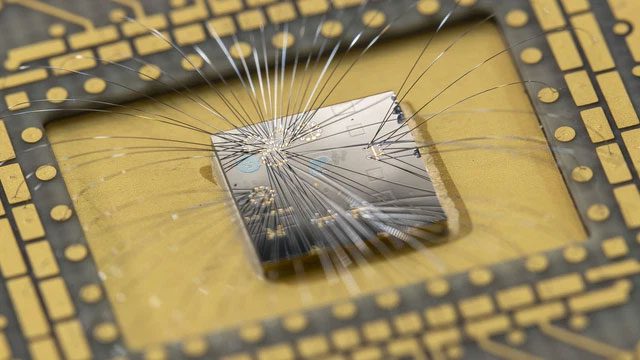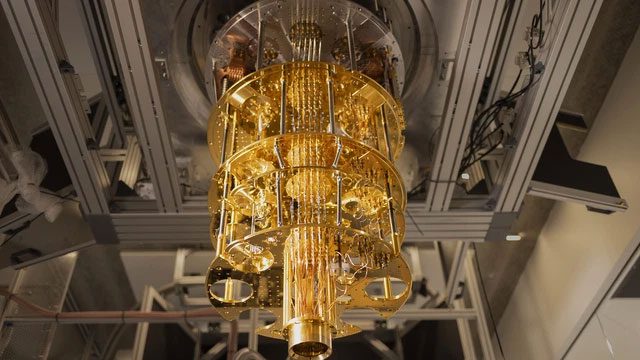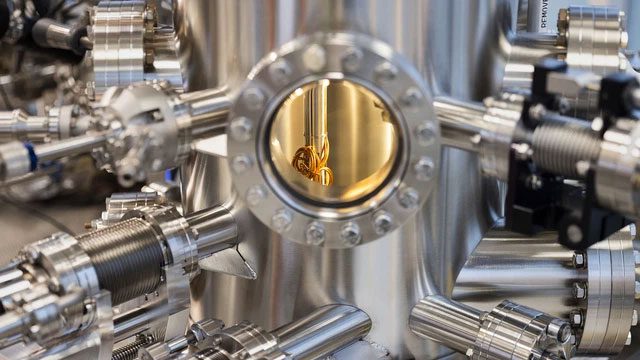The research project on Azure Quantum quantum computing by Microsoft has successfully developed a special device capable of producing quantum characteristics that science has long discussed but has never been successfully realized in the real world.
This breakthrough is a key step towards successfully creating a new quantum bit (qubit) with high stability, laying the groundwork for the development of a large-scale quantum computer.

Quantum chip developed by Microsoft.
“It’s amazing to see humans being able to create one of the strange aspects of physics in the universe. We hope to harness it to achieve what seems impossible – to produce a quantum computer with an acceptable error rate, pushing computing to a new level, closer to how the natural world operates,” said Krysta Svore, a Microsoft engineer and leader of the quantum software development program.
Built on two decades of research and efforts to create advanced simulation programs, the Azure Quantum team has developed a device that produces the topological state of matter trapped in a Majorana zero mode pair*.
|
*History of Majorana zero mode – MZM (according to the scientific journal PNAS): In 1937, Italian theoretical physicist Ettore Majorana pointed out that, unlike Dirac’s equation which describes electrons and their antiparticle positrons, there exists another state where a fermion particle is also its own antiparticle**. Although this particle has not yet been discovered by particle physicists (as of this time), the hypothesis suggests that a pair of Majorana states may exist at the end of a superconductor designed in a special way. These Majorana zero modes can form qubits for a quantum computer with an acceptable error rate. ** Antiparticle: In particle physics, for every type of particle, there exists an antiparticle with the same mass but opposite properties (for example, opposite charge in electromagnetic terms or opposite color charge in the context of quantum chromodynamics). |
As far as we know, the special quantum state MZM does not exist in nature and can only appear under extremely precise conditions. Science has long sought to create them in the laboratory.
At this point, the Azure Quantum research team has been able to create what is called a topological state, while also measuring the topological distance and assessing the stability of the state.

Setup used to keep the quantum computer stable in extremely cold environments.
From here, Microsoft can create a special qubit, known as topological qubit. According to Microsoft, their future quantum machine will have higher stability compared to other types of qubits, allowing it to reach unprecedented scales. Quantum computers, regarded as the next evolutionary step in computing and supercomputing, will leverage quantum mechanics (the science that describes the behavior of subatomic particles) to process information in ways that humans have yet to imagine.
“Finding a way to eliminate hunger and save the Earth from climate change will require us to explore and optimize molecular particles, tasks that are impossible with classical computers, and that’s when quantum computers come to the rescue,” said Zulfi Alam, president of Microsoft’s quantum division.
However, before these ambitious plans become a reality, Azure Quantum estimates that a quantum computer must be at least 1 million qubits strong. Currently, quantum computer systems not utilizing Microsoft’s new techniques are only stronger than 100 qubits, and scaling these machines remains a challenging problem to solve.
This is why Azure Quantum focuses on researching topological qubits, which are believed to be faster, smaller, and less prone to data loss than conventional qubits. Over the past year, the Azure Quantum hardware research team has been tirelessly working to test and prove that this new quantum state is stable.

Microsoft researchers are currently assembling the quantum computing device.
Experts at Microsoft’s Copenhagen Quantum Materials Laboratory have also spent years researching and perfecting techniques that allow engineers to create machines with atomic-level precision. Thanks to tireless efforts, Microsoft has achieved a new breakthrough.
However, the leaders of Microsoft’s quantum division remain cautious, as there is still a tremendous amount of work ahead. A quantum computer that can scale as desired is still a dream at this point.
But with this new breakthrough, coupled with the emergence of advanced simulation systems and extremely high-precision devices, the project is gradually taking shape, no longer completely shrouded in mystery.
“There are no longer significant obstacles in producing topological qubits,” said senior manager Lauri Sainiemi. “This does not mean we are done – there is still a ton of work to do. But the fundamental issues have answers, and now we are approaching technical problems, which is what we will pursue.”





















































